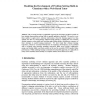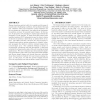48 search results - page 6 / 10 » Predicting future object states using learned affordances |
PAMI
2012
11 years 10 months ago
2012
—We present a novel framework to generate and rank plausible hypotheses for the spatial extent of objects in images using bottom-up computational processes and mid-level selectio...
ITS
2004
Springer
14 years 1 months ago
2004
Springer
This research describes a probabilistic approach for developing predictive models of how students learn problem-solving skills in general qualitative chemistry. The goal is to use ...
ICCV
2009
IEEE
15 years 23 days ago
2009
IEEE
Labeling image collections is a tedious task, especially
when multiple labels have to be chosen for each image. In
this paper we introduce a new framework that extends state
of ...
ICRA
2010
IEEE
13 years 6 months ago
2010
IEEE
Abstract— For many tasks in populated environments, robots need to keep track of present and future motion states of people. Most approaches to people tracking make weak assumpti...
MM
2009
ACM
14 years 2 months ago
2009
ACM
Human visual perception is able to recognize a wide range of targets under challenging conditions, but has limited throughput. Machine vision and automatic content analytics can p...



